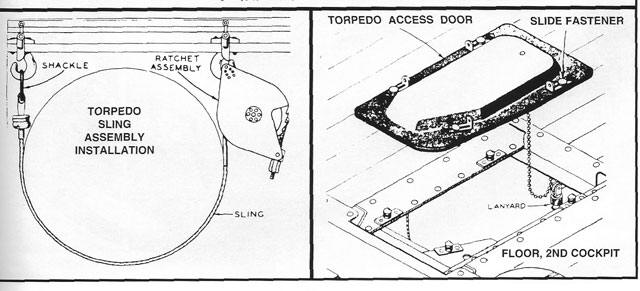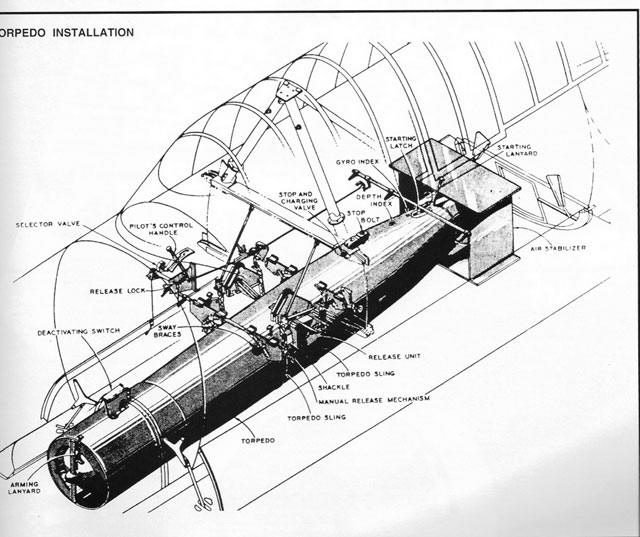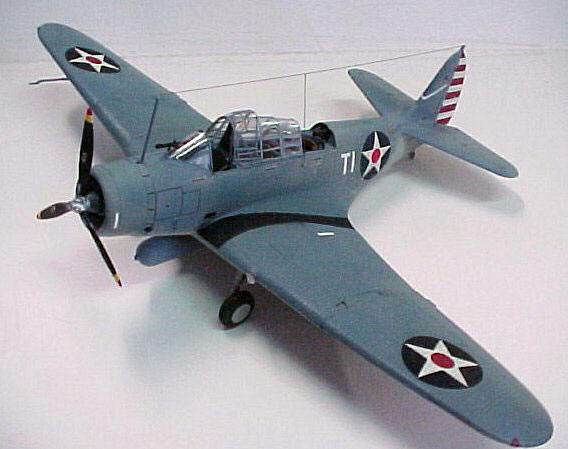|
TBDs and the
Mk XIII Torpedo
The March 10, 1942 Raid on
Lae-Salamaua:
VT-2 Takes on
the Owen Stanley Ranges
in 1/48 Scale
Figure SEQ Figure \* ARABIC 1.
No Close Ups of VT-2 TBDs with Torpedoes Survive: This is a VT-6
Aircraft in October 1941. Note the slings hanging down under the
second cockpit.
by
Joe Lyons

HyperScale is proudly supported by
Squadron.com
This raid by Lexington and Yorktown
was intended to cover a troop convoy between Noumea and Australia while
at the same time complying with Admiral King’s simple order to “attack
the enemy.” Japanese ships present after the March 8 landings at
Lae-Salamaua on Huon Gulf, in the bight of New Guinea facing the Bismark
Sea, provided the targets. Details of this raid can be found in
References d and f.
The article presents one of the 13 TBDs
Lexington put up from Torpedo Two armed with the Mk XIII aerial
torpedo. These aircraft executed torpedo attacks on several (I have not
found an exact count) ships in the Huon Gulf. One hit was claimed, per
reference d; the rest of the torpedoes malfunctioned. This use of the
Devastator was of course a requirement of the aircraft when the Request
for Proposal that resulted in its production was issued in 1934. Its use
as a torpedo bomber on March 10 was known to be a bit of a gamble while
the mission was being planned, the 10000 ft-plus height of the subject
mountain range providing a challenge to the heavily loaded TBDs. It
looked at first that VT-2 would not be able to climb over the mountains,
and would be forced to turn back. However, the C.O. Lt Cdr James Brett,
an experienced glider pilot, noted some portions of the jungle-covered
peaks in cloud-induced shadow. Knowing the relatively cool shadowed
terrain produced thermal updrafts he led the TBDs to them and thereby
got enough of a boost to get to the other side.
The Airplane
The TBD entered service in 1937; ultimately 144
were built. It equipped all of the VT squadrons in service in December
1941, and was to have a busy war in its seven months of front-line
service. Its primary mission of course was torpedo delivery, but it was
used as a bomber on several occasions. The TBD had three crew positions,
pilot, assistant pilot/bombardier and radioman gunner. Usually but not
always, the middle seat was not occupied during torpedo missions. It is
not known for sure how VT-2 was manned that day (my guess is two), but
in May 1942 during attacks on two carriers at the Battle of the Coral
Sea, it happens there were three aboard at least two of its aircraft.
The TBD, no matter how gallantly flown, does not
bring much of a reputation to us down through the years. But, reflect on
this: in less than a month in mid-summer 1942, 84 torpedo-armed TBDs
were launched at seven Japanese carrier targets. 55 (65%) go to weapons
release range. An admirable record, the lamentable Mk XIII
notwithstanding.
The Torpedo
The Mk XIII was the first and last purpose-built
large steam aerial torpedo actually fielded by the US Navy, although
there were other experimental designs. Its development was typical of
many done during a budget-poor peacetime, primarily the failure to
adequately test the weapon in operational conditions. There were
political reasons as well.
The photo of the model torpedo shows a Mk XIII
installed on a TBD; all the multi-seat carrier bombers that used this
weapon (TBD, TBF/M, TBU/TBY) apparently mounted it in the same way. Two
slings supported the torpedo, in the case of the TBD the ends of the
slings terminated at the bomb racks on either side. One end of a sling
was fixed; the other end was releasable to drop the weapon.
Sliding into formation a short time later was Leonard (Lt (jg) William
N, VF-42) who saw the TBDs drawing away from the target, the torpedo
brace straps dangling underneath the lumbering Devastators.
[Reference b]
Two big crutches serving as sway braces secured the
torpedo laterally. Fore and aft movement when mounted on the airplane
was prevented by a stop bolt inserted into a receptacle in the top of
the weapon through a hole in the bottom of the fuselage (in the TBD’s
case). The bolt stayed behind on drop. Torpedo running depth could be
changed in flight by means of a skate key-like device that accessed a
valve on the torpedo via a small hatch in the airplane. Two other
non-carrier navy aircraft, the PBY and the PBM, used the Mk XIII in
combat. USAAF B-25s and B-26s also made limited use of them. The flying
boats almost certainly used the sling arrangement. Those of you who know
what a skate key is, probably also know how to wind a watch as well as
cope with rotary dial phones.

Figure SEQ Figure \* ARABIC 2 Slings, and Access Hatch to bolt & valve:
TBY

Figure SEQ Figure \* ARABIC 3 TBY Torpedo Installation (TBF/M similar)
Less than 10% of Mk XIIIs dropped in combat by TBDs
scored, mostly because the torpedo malfunctioned. The malfunctions were
known pre-war but ignored by the navy Bureau of Ordnance whose
responsibility they were. The weapon would eventually become reliable
and effective, but the entire story of USN pre-war torpedo development
is an abysmal one and reflects no credit on that service.
Monogram's 1/48 scale TBD
|
The TBD may fall into that category of “Never have so few been
modeled by so many.” The Monogram kit remains king of this scale after
30 years. IMHO this kit had stood up well in the 30 years since it was
released; we are unlikely to see a replacement in this scale much less
at this price. Those who continue to buy and build Monogram P-47s rather
than Tamiya P-47s know what I mean. Part of the Eduard P/E set for the
TBD is used in this model, most visibly the flaps and front cockpit
detail. There are fit issues with some internal parts and the
wing-fuselage joins.

Click the thumbnails below
to view larger images:
Color and Markings
Although you cannot tell from the photos the model represents BuNo
0300, delivered to VT-2 in 1937 and marked “2-T-1.” 0300 spent its
entire operational life on USS Lexington (CV-2); the two rest
together to this day. I do not know if it was still the skipper’s
aircraft on March 10, 1942 but I like to think it was. By that date the
original Golden Wings colors had been overpainted first, by Overall
Light Gray and then by Blue-Gray on the upper surfaces in the fall of
1941. There is some fading of this color, particularly on the fabric
control surfaces. There is no way of knowing if 0300, originally
delivered with aluminum lacquer interior surfaces, was repainted with
Bronze Green during some pre-war depot period, but I’ve assumed it was.
The torpedo is painted with MM Steel Metalizer (afterbody) and a light
gray warhead.
The markings are standard six-position national insignia for the
period, accompanied by those red and white stripes on the rudder. A
white LSO stripe and “T 1” (reference c) in white finish off the simple
markings. The Lexington CAG was unique in retaining white numbers and
codes post Pearl Harbor. This is no photo confirmation (available at
least to this mere mortal) of the rumor that CAG-2 also retained full
squadron markings into 1942. There is no evidence that it did not,
either.
All Photos and Drawings USN or the Author.
a.
Adcock, A. (1989). TBD Devastator in Action. Carrollton,
TX: Squadron/Signal Publication.
b.
Lundstrom, J.B. (1984). The First Team. Pacific Naval Aircraft
Combat from Pearl Harbor to Midway. Annapolis, MD: Naval Institute
Press.
c.
Morison, S. E. (1968). History of United States Naval
Operations in World War II: Vol III The Rising Sun in the Pacific.
Boston: Little, Brown and Company.
d.
Tillman, B. (2000). TBD Devastator Units of the US Navy.
Oxford: Osprey Publishing.
e.
Wilmott, H.P. (1983). The Barrier and the Javelin Japanese and
Allied Pacific Strategies February to June 1942. Annapolis, MD:
Naval Institute Press.
Model and Text Copyright © 2005 by
Joe Lyons
Photos and Drawings by USN or
Joe Lyons
Page Created 27 March, 2005
Last Updated
26 March, 2005
Back to
HyperScale Main Page |
Home
| What's New |
Features |
Gallery |
Reviews |
Reference |
Forum |
Search